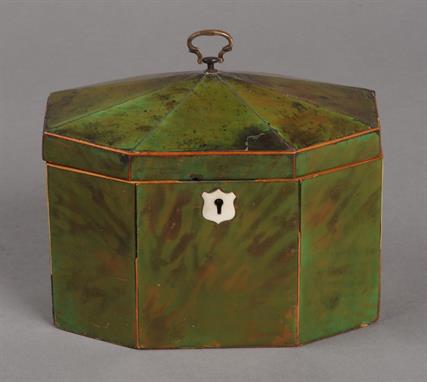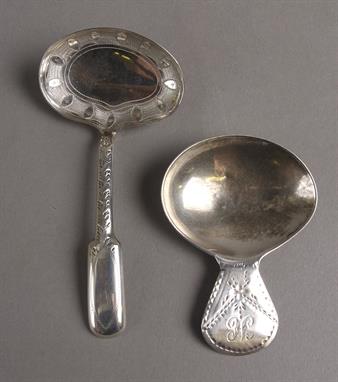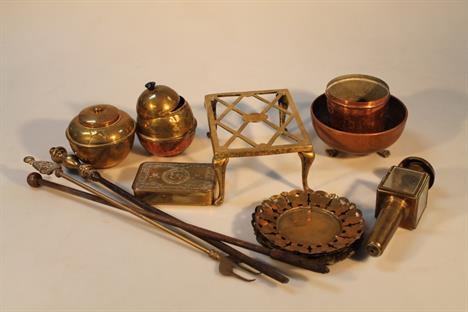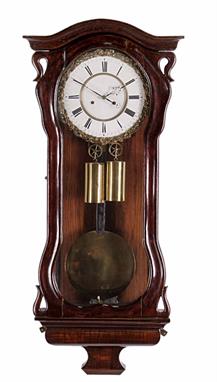A collection of silver to include a Georgian silver caddy spoon, of leaf form with engraved detail, a shell form butter dish, c.1888 together with matching butter knife, a silver pot and cover with plain form with engraved decoration to cover, a silver cigarette case, hip flask, small cream jug, silver oblong box with embossed scroll decoration to cover and a boxed silver spoon with bright cut decoration, approx gross weight 18.7oz. (lot)
81693 Preisdatenbank Los(e) gefunden, die Ihrer Suche entsprechen
81693 Lose gefunden, die zu Ihrer Suche passen. Abonnieren Sie die Preisdatenbank, um sofortigen Zugriff auf alle Dienstleistungen der Preisdatenbank zu haben.
Preisdatenbank abonnieren- Liste
- Galerie
-
81693 Los(e)/Seite
An early 20th Century reproduction mahogany cased bracket clock in the Georgian style, the case with a reeded caddy top, brass sway handle, strung line inlay and pierced side panels, enclosing the silvered dial signed W. Payne & Co, London, the eight-day twin fusee movement striking on a gong, width 24cm.
A good quality early 20th Century mahogany ladies mahogany inlaid roll top Desk, the superstructure having a central shield shaped mirror flanked by two caddy topped cupboards having oval inlay over a similarly inlaid roll top enclosing fitted pigeonholes and drawers and a tooled leather sliding writing surface, further over two moulded edge frieze drawers having circular gilt metal handles, the whole supported on moulded square legs united by a double 'Y' form stretcher, 120cm high x 82cm wide
A LATE GEORGE III GREEN STAINED TORTOISESHELL TEA CADDY, of irregular octagonal outline with silvered and boxwood stringing, having a domed cover with loop handle, the interior fitted with two lidded compartments, with later ivory escutcheon, 13.5cm high x 16.5cm wide (losses and damages). See illustration
A fine French engraved gilt brass centre seconds carriage clock with spring detent `chronometer` escapement and push-button repeat Bollviller, Paris, circa 1845 The gilt eight-day two train bell striking movement with underslung spring detent escapement and vertical rim monometallic balance with blued steel timing screws and helical balance spring mounted via a bridge with column turned uprights onto a large linear engine-turned platform, the backplate stamped with oval BOLLVILLER, A PARIS trademark to lower margin, the rectangular white enamel Roman numeral dial with centre seconds, blued steel Breguet style moon hands and repeat signature BOLLVILLER A PARIS in a curve below, the gilt one-piece caddy moulded foliate scroll engraved bevel-glazed case with hinged carrying handle and repeat button fitted towards the front edge of the top glass, the rear door with shuttered winding holes within a rococo-scroll engraved gilt field, on cavetto moulded skirt base with recessed rounded angles, the inner base plate stamped L. LANGE 84 to underside, 14cm (5.5ins) high excluding handle. Bolviller is recorded in Allix, Charles and Bonnert, Peter CARRIAGE CLOCKS, Their history and development as working from various addresses in Paris from circa 1830-70; Rue Saint-Avoye 1830, Rue Charlot 1840, Rue Vendome 1850-60 and Rue Beranger 1870. L. Lange is also recorded by Allix as a specialist carriage clock case maker whose stamp appears mainly on one-piece cases housing movements by Auguste, Jules and Japy amongst others. The current lot is unusual and rare in that it is fitted with a spring detent `chronometer` escapement and has centre seconds. The design of the bridge for the balance, as well as the engine turned detail to the platform, can be directly compared to an underslung pointed-tooth platform lever escapement fitted to a very similar but non centre seconds carriage clock signed by Jules, Paris, illustrated in Allix, Charles and Bonnert, Peter CARRIAGE CLOCKS, Their history and development pages 74-5 (figs II/50 and II/51). Indeed these similarities add weight to the suggestion made by Allix that these clocks originated from the same manufacturing process/workshop.
A rare French petit sonnerie striking carriage clock with two-plane `chaffcutter` escapement and push-button repeat Paul Garnier, Paris, circa 1840 The eight-day two train movement with two-plane `chaffcutter` escapement and three-arm monometallic balance set between the plates and striking the hours and quarters on a pair of graduated bells mounted to the backplate signed PAUL GARNIER, H`LR DU ROI PARIS towards upper left hand corner and numbered 1183 to centre, the rectangular engine-turned silvered brass Roman numeral dial with radial design to centre within chapter ring and `watered-silk` infill incorporating vacant signature plaque to lower margin and with Breguet style blued steel moon hands, the gilt brass one-piece caddy moulded case with hinged slender baton handle above repeat button mounted within the top glass panel and the rear sliding upwards for winding, on cavetto moulded skirt base with inset rounded angles, (strike train with faults), 14.5cm (5.75ins) high excluding handle; with original leather covered outer travelling case. Paul Garnier is recorded in Allix, Charles and Bonnert, Peter CARRIAGE CLOCKS as born 1801 and receiving Silver Medals in the Paris Exhibitions of 1827, 34, and 39; and gold medals in 1844 and 49. He worked from various addresses at Rue Taitbout, Paris and died in 1869 leaving the business to his son of the same name who was still exhibiting carriage clocks in the Paris Exhibition of 1889. Paul Garnier is generally credited for being the first maker to essentially standardise the `petit pendule portative` which was in effect to become the prototype for the archetypal French carriage clock. The current lot with its `chaffcutter` escapement, engine turned `watered-silk` dial and squat one-piece case with wooden block insert to underside can be firmly identified as a `Series I` carriage clock by Garnier as identified by Allix (see Allix, Charles and Bonnert, Peter CARRIAGE CLOCKS pages 56-7). This clock is rare in that it was made with petit-sonnerie striking and has particularly early use of repeat button set into the top glass of the case.
A Regency mahogany mercury stick barometer L. Bellatti, Grantham, early 19th century With open triangular pediment above glazed rectangular silvered vernier scale calibrated in barometric inches and with the usual observations, beside an alcohol tube Fahrenheit scale thermometer and signed L. Bellatti, Grantham to upper margin, the caddy moulded trunk with exposed tube over rounded base with hemispherical cistern cover, 97cm (38ins) high. Louis Bellatti is recorded in Banfield, Edwin BAROMETER MAKERS & RETAILERS 1650-1900 as a maker of angle barometers working in Grantham circa 1825-45.
A Victorian figured mahogany mercury stick barometer L. Bellatti, Lincoln, mid 19th century With cavetto moulded upstand above glazed canted ivory vernier scale calibrated in barometric inches together with the usual observations and signed L. Bellati, LINCOLN to upper margin opposing mercury tube Fahrenheit and Centigrade scale thermometer, the flame figured caddy moulded trunk with vernier adjustment square to throat above circular base with moulded domed cistern cover and level adjustment screw to underside, 97cm (38ins) high. Louis Lawrence Bellatti is recorded in Banfield, Edwin BAROMETER MAKERS & RETAILERS 1650-1900 as working from 34 Steep Hill, Lincoln 1849-68.
A Victorian rosewood mercury stick barometer Lee and Son, Belfast, late 19th century With moulded pediment above bevel-glazed canted ivory double vernier scale calibrated in barometric inches and signed Lee & Son, BELFAST to upper margin, the caddy moulded trunk with vernier adjustment squares and foliate carved ears to throat above arched mercury tube Fahrenheit and Centigrade scale thermometer and base applied with urn shaped domed cistern cover over level adjustment screw to the ogee moulded underside, 97cm (38ins) high. Joseph Lee and Son are recorded in Banfield, Edwin BAROMETER MAKERS & RETAILERS 1650-1900 as working at 57 High Street, Belfast circa 1850-70.
A simulated rosewood and stained walnut Vienna `regulator` wall clock Unsigned, mid 19th century The eight-day gong striking weight driven movement with deadbeat escapement and fine beat adjustment to the long crutch engaging with the wood rod pendulum with large diameter brass faced lenticular bob, the two-piece white Roman numeral enamel dial with fine pierced blued steel hands and elaborate foliate scroll cast brass bezel, the case with shallow arch cavetto cornice above waisted front door with naturalistic dished surround incorporating pierced stylised scrolls to each corner, the base formed as a generous ogee moulded inverted caddy, 73cm (28.75ins) high.
A Victorian figured mahogany mercury stick barometer Frankham, London, late 19th century With canted pediment and lappet carved frieze above bevel-glazed canted silvered brass vernier scale calibrated in barometric inches together with the usual observations, annotated YESTERDAY 9 A.M. and TODAY 9 A.M. to lower margin and signed Frankham, 40 Baker Str., Pentonville to upper margin flanking large-bore mercury tube, the fine flame figured and ebony strung caddy moulded trunk with vernier adjustment squares to throat above circular base with moulded domed cistern cover and level adjustment screw to underside, 97cm (38ins) high. Richard William Frankham is recordedin Banfield, Edwin BAROMETER MAKERS & RETAILERS 1650-1900 as working from 40 Baker Street in 1872, 5 Little James Street 1887-89 and 28 Anwell Street from 1895.
A Queen Anne style brass mounted walnut mercury pillar barometer Unsigned, in the manner of Daniel Quare, early 20th century The rectangular engraved brass superstructure enclosing two-piece silvered scale divided for barometric inches and annotated with summer and winter observations beneath grotesque mask engraved caddy flanked by brass finial-shaped recording pointer adjustment screws, above floral decorated rectangular panel to throat and tube concealed within Doric column-turned upright with cavetto moulded upstand to capital and brass collars to the spiral fluted lower section of the shaft, the base with moulded cylindrical cistern, 92cm (36.25ins) high; with a large alcohol Fahrenheit scale thermometer, recent, with arched brass plate in arch-glazed mahogany case with cavetto moulded base, 61.5cm (24.25ins) high, (2).
A French engraved gilt brass carriage clock with push-button repeat Unsigned, late 19th century The eight-day gong striking movement with silvered platform lever escapement and stamped 2602 to backplate, the rectangular white enamel Roman numeral dial with blued steel spade hands, the bevel glazed corniche case with hinged carrying handle and engraved with floral blooms within rococo scroll bordered panels to top above repeat foliate lozenge decoration to caddy moulded angles, the base with further floral scroll motifs on a matted ground, 14cm (5.5ins) high excluding handle.
-
81693 Los(e)/Seite



























































